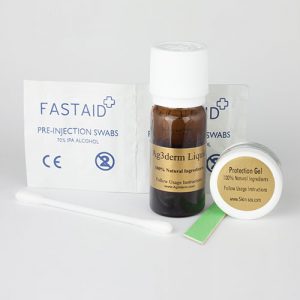Keratosis And Pigmentation In Children
2nd August 2010What Is An Actinic Keratosis?
31st July 2010Actinic keratosis can also be called by the name solar keratosis. It is just a small spot with rough skin that can occur on the skin area that is primarily exposed to sun. The general measurement for the actinic keratosis is in between 2-6 millimeters in diameters. Usually they appear in reddish color along with rough surface and many times they are pointed with yellow or white scale. Actinic keratosis may occur as a result of sun damage that also includes wrinkles, age spots, blood vessels and sallowness.
Additionally, the rubbing with fingers and some cloth on actinic keratosis can also cause some painful feeling. A cutaneous horn is a specialized form of actinic keratosis in which the skin stick out from a surface in a hard hornlike manner that mention for scaling and having the surface that is not even or regular of lower lip and blurring the lip border and near to skin. [continue reading…]
Keratosis Treatment | Beware Of Liquid Nitrogen
29th July 2010The use of cryogens or cryotherapy, curettage, laser therapy, electrocautery or surgical excision all aid in treating keratoses – the first being the most popular keratosis removal method. Studies reported that it is the second-most common procedure next to surgical procedures such as skin excision and it can easily be performed in the doctor’s office.
Various bothersome skin lesions such as warts, actinic keratosis or seborrheic keratosis are frozen off from the body through the utilization of very low temperatures – the process termed as cryotherapy. Due to failed trials in removing deeper and thicker lesions, this regimen is recommended only for superficial or flat lesions. [continue reading…]
The Three Main Types Of Keratosis And Ways To Treat Them
28th July 2010Are you wondering what those blemishes on your skin are? This is called keratosis – the growth of excess protein named keratin in the skin. In general, treatment is undertaken for the following reasons: to prevent its development into cancer or other malignant tumors; or in cases of benign keratosis, to eliminate discomfort or plainly to remove the presence of these unsightly skin blemishes. The most important thing to consider before choosing the treatment that is right for you is to let a specialist identify your keratosis type and to find out its cause. This will be a bit hard for there are three most common types of keratosis. These are actinic keratosis, seborrheic keratosis and keratosis pilaris which we will be disussing along with their respective treatments. [continue reading…]
Don’t Take Chances With Actinic Keratosis
26th July 2010Skin cancer is one of the most frequently diagnosed of all cancers, exceeding even colorectal, prostate, breast, and lung cancer. Skin cancer is the most pervasive cancer in the population’s 20 – 39 age bracket. Unknown to the greater majority, actinic keratosis is known to be potentially precancerous and can develop into the skin cancer squamous cell carcinoma if left untreated. Lesions from actinic keratosis that are left untreated have a 20% risk of progressing into that particular cancerous disease.
Otherwise known as solar keratosis or senile keratosis, actinic keratosis often appears as small, rough patches of skin that are 2-6 mm each in diameter. These lesions are often red, sore, and painful to the touch. You can also sometimes see white or yellow scales on them. [continue reading…]
Forms of Porokeratosis and General Treatment
24th July 2010Porokeratosis has several names that are associated with it. These include senile keratosis, senile warts, seborrheic verruca, barnacles, brown warts, and basal cell papilloma. It is a clonal keratinization disorder, which manifests as a cornoid lamella. A cornoid lamella is composed of closely stacked parakeratotic cells that extend throughout the stratum corneum.
Currently, there are five variations of porokeratosis that are known. Here are the five clinical variations of porokeratosis: porokeratosis palmaris et plantaris disseminate, punctate porokeratosis, linear porokeratosis, disseminated superficial actinic porokeratosis, as well as classic porokeratosis of Mibelli. Disseminated superficial actinic porokeratosis is rather widespread in the United States. The remaining four variants are rarer in occurrence. [continue reading…]
Fraxel Laser Keratosis Treatment
22nd July 2010The most dreaded thing on earth by most people are the words aging and cancer, the sun can cause both and many of us expose our skin to the sun with none or not enough protection. Since aging is unavoidable, there are ways to postpone it and sustain youthfulness. Having wrinkles and fine lines accompany the aging process. Dark spots and keratoses on the skin also appear as a person ages.
Dark spots and actinic keratosis on the skin are caused by exposure to the sun. These are essentially sun damage to the skin and Actinic Keratoses must be treated as soon as possible as they are precancerous lesions. However, treated early they can be cured. [continue reading…]
The Effects Of Glycolic Acid Face Peel on Keratosis
21st July 2010Glycolic acid is known to be part of the alpha hydroxy acid (AHA) family belonging to carboxylic acids. Because of its characteristics that are commonly used in industrial application and consumer application, glycolic acid can be considered as different from sugarcane. One application that is widely used is the use of glycolic acid for personal skin care products. Glycolic acid face peel is made out of glycolic acid that functions to improve the appearance of the skin and fight pimples, wrinkles, sun damaged skin, actinic keratosis and uneven pigmentation. [continue reading…]
Protect Your Child from Keratosis & Pigmentation
19th July 2010A child’s skin is very sensitive, unlike adults. Skin care for children should be gentle, because skin damage in childhood could carry on until he gets old. For example, if a child always stays under the harmful rays of the sun, he or she could develop freckles. Freckles are the skins method of natural protection and could carry on later in life.
There are certain risks for having skin disorders, and we’ll take the case of keratosis and pigmentation. The two body components that involve these skin disorders are keratin and melanin. Keratosis is the overproduction of keratin (protein component of hair and nails) while pigmentation is the overproduction of melanin (responsible for skin tone). Keratin and melanin are actually important to our body. Keratin makes up our nails and hair, while melanin protects the skin. Excessive keratin and melanin does not always have severe adverse effects, but just harms the appearance of the skin. [continue reading…]
Actinic & Seborrheic Keratosis
14th July 2010Hyperkeratinization on skin is the main cause of keratosis. Keratin makes up the hair and nails of humans. When it is produced out of proportion, some skin problems like keratosis could occur. There are many types of keratoses, each varying in nature and causes.
Actinic Keratosis
Solar keratosis or senile keratosis is actinic keratosis technically. This skin condition often occurs to older people, and to people who get too much sun exposure, thus the names senile or solar keratosis. Actually, it can be a precancerous warning sign and can lead to squamous cell carcinoma. Actinic keratoses are wart like bumps which are rough, scaly but non viral. Since it is one of the skin cancer warning signs, it must be paid attention to and removed under the supervision of a dermatologist. [continue reading…]

